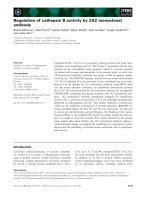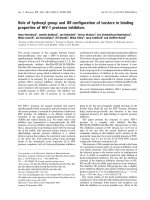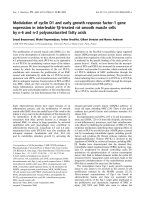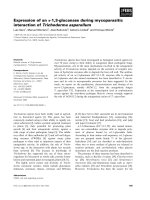Báo cáo khoa học: "Combination of an Automatic and an Interactive Disambiguation Method" docx
Bạn đang xem bản rút gọn của tài liệu. Xem và tải ngay bản đầy đủ của tài liệu tại đây (381.63 KB, 5 trang )
Combination of an Automatic and an Interactive
Disambiguation Method
Masaya Yamaguchi, Takeyuki Kojima,
Nobuo
Inui, Yoshiyuki Kotani and Hirohiko Nisimura
Department of Computer Science, Tokyo University of Agriculture and Technology,
Nisimura, Kotani unit, 2-24-16 Naka-cho, Koganei, Tokyo, Japan
Abstract
In natural language processing, many methods have
been proposed to solve the ambiguity problems. In
this paper, we propose a technique to combine a
method of interactive disambiguation and automatic
one for alnbiguous words. The characteristic of our
method is that the accuracy of the interactive dis-
ambiguation is considered. The method solves the
two following problems when combining those dis-
ambiguation lnethods: (1) when should the inter-
active disambiguation be executed? (2) which am-
biguous word should be disambiguated when more
than one ambiguous words exist in a sentence? Our
method defines the condition of executing the inter-
action with users and the order of disambiguation
based on the strategy where the accuracy of the re-
sult. is maximized, considering the accuracy of the
interactive disambiguation and automatic one. Us-
ing this lnethod, user interaction can be controlled
while holding the accuracy of results.
1 Introduction
In natural language processing, many methods
have been proposed to solve the ambiguity prob-
lems(Nagao and Maruyama, 1992). One of those
technique uses interactions with users, because it is
difficult to make all the knowledge for disambigua-
tion beforehand. That technique is classified into
two types according to the condition of executing
user interaction. One type(TypeA) is that the dis-
ambiguation system executes interactions(Blanchon
et al., 1995),
(Maruyama and
Watanabe, 1990),
(Yalnaguchi et al., 1995). Another type(TypeB) is
that users executes interactions(D.Brawn and
Niren-
burg,
1990), (Muraki et
al., 1994).
In thispaper, Ty-
peA will be adopted because TypeB gives users more
trouble than TypeA does. For example, in TypeB,
a user may have to find where is wrongly analyzed
in input
sentences.
In TypeA, the two following conditions must
be
determined: (1) when should interactive disam-
biguation be executed? (2) which ambiguous words
should be disambiguated when more
than one
aln-
biguous word exist in a sentence? Considering
the
accuracy of tile analyzed result, they should be de-
cided by both the accuracy of the interactive dis-
ambiguation and that of tile autolnatic disambigua-
tion. The traditional lnethods did not considered
the accuracy of the interactive disambiguatiom For
instance, the accuracy of the analyzed result may
decrease in spite of executing the user interaction
if the accuracy of the interactive disaml)iguation is
low.
In this paper, we propose the method to com-
bine the interactive disambiguation and the auto-
matic one, considering each accuracy. The method
allows the disambiguation system to maximize the
accuracy of the analyzed result. This paper focuses
on the anabiguity caused by ambiguous words that
have more than one mealfing. Section 2 represents
preconditions for disamlfiguation. In Section 3, we
descrihe the condition of executing the interactive
disambiguation. Section 4 shows the procedure
that
decides the order of disamhiguation. The perfor-
mance of the lnethod is discussed by the result of
the sinmlation under assumhlg the both accuracy
of the interactive disambiguation and the autolnatic
one.
2 Preconditions for Disambiguation
This section describes preconditions for disambigua-
tion and methods of the disamlfiguation.
In this paper, the disambiguation for ambiguous
words means that all ambiguous ones in an input
sentence a.re disambiguated. Describing it. formally,
the
disambiguation is to decide one element of the
following
MS.
MS = M1
x
M2
x
x
slit,
where an input sentence contains ! ambiguous
words. Mi
means the set
of lneanings in the am-
biguous word
wi.
Each disambiguation method has preconditions as
follows:
Interactive Disambiguation
• In the interaction, the system shows explana-
tions for each meaning of an ambiguous word to
a user, who selects one explanation from them.
1423
• The system can calculate the probability where
a user selects the right explanation.
Automatic Disambiguation
• The occurrence probabilities for each candidate
can be calculated for preference.
• The result is the candidate with the maximum
occurrence probability.
To show the iuformation mentioned above, candi-
dates are expressed by the tree in Figure 1. This tree
is an example in the case that an input sentence is "I
saw a star.", which contains two ambiguous words
'see' and 'star' and each word has two meanings.
root
771~1 1
77112 1711n
Pdl, Pl Pd-~, P.~ Pdn, P,
Figure 2: An example of the tree of candidates for
one ambiguous word in an input sentence
The accuracy of the interactive disambiguatiou
/~ntr
and that of the automatic disambiguation Pauto
are defined as follows:
root.
see_l see_2
Pdll Pdl2
sta~_l
stax_2 star_l star_2
Pd2_l, Pll Pd22, P12 Pd21, P21 Pd22, P'_'2
Figure 1: All example of the tree of candidates
The depth of the tree expresses the order of dis-
anfl)iguation. In Figure 1, the auabiguities are re-
solved in the order from 'see' to 'star'. The occur-
fence probability is calculated at each leaf node by
the automatic disambiguation method. For exam-
pie, PH expresses the probability for the candidate
{see_l,star_l}. Furthermore, the accuracy of in-
teraction is also calculated at the leaf node by the
interactive disalnbiguation method. Pd~.l is the prob-
ability where the meanillg of 'star' is 'staLl' and
tim system shows explanations of
'star_l', 'star_2'
for 'star' to a user a.nd (s)he selects the explanation
of 'star_2'. At. Nodes besides leaf ones, only the
accuracy of interaction is calculated.
3 The Condition of Executing the
Interactive Disambiguation
3.1 Basic Idea
At each node besides leaf ones, the disambigua-
tion system decides which disambiguation method
is used. Basically, the interactive disambiguation is
executed when its accuracy is higher than the ac-
curacy of the automatic disambiguation. First of
all, let us consider the case where an input sentence
contains one ambiguous word that has ~, meanings.
Figure 2 shows the tree of candidates for this case.
Pintr £ PdiPi
i
P~uto = maxp~
The interactive disambiguation is executed, when
the following condition is satisfied.
Pintr > Pauto
Considering tile condition more carefully, the ac-
curacy of tile interactive disambigualion is iuflu-
enced by the explanations that are showu t.o users.
Thus tim accuracy may be improved by limiting to
show some explanations to users. For example, this
may be caused when the accuracy of roll is very low
and a user may select mll wrongly by the higher
similarity of the explanation for 11111 to other expla-
nations. The autonmtic disambiguation corresponds
to showing only one explanation to users in the in-
teractive disanabiguation. Therefore the condition
of executing the interactive disambiguatiou can be
defined as the exceptional case of the limitation.
3.2 The Accuracy at a Node
In the case that the number of alnbiguous words is
one as Figure 2, the accuracy of the deeper nodes be-
low the root node needs not to be decided because
they are leaf nodes. When more than two ambiguous
words exist in an input sentence, a node may often
have one that is not a leaf one. To calculate the ac-
curacy of such a node, it is necessary to determine
what kind of disambiguation will be executed at the
deeper nodes. For instance, the disambiguation sys-
tem has to fix each accuracy of node 'see_l' and
'see_2' in Figure 1 to calculate the accuracy of the
root node. Therefore, the definition of the accuracy
at any node i is the recursive one. The accuracy of
the interactive disambiguation Pintr(i) and that of
the automatic disambiguation P~,to(i) at node i is
defined as follows:
1424
Ptntr(i) = ~
pd(,nlM ) x P,(m)
(1)
rnEM .
Pluto(i) = max(Pr(m)) (2)
m
E
M
where M is the set of the node directly under node
i, pd(m[M) is the accuracy of the interactive disam-
biguation at node m, that is, the probability that a
user selects m provided that the system shows ex-
planations for all the elements of M to him(her).
Pr(m) is the accuracy at node m and the definition
is as follows:
P~(,,)
=
(if the interactive disambiguation is
executed a,t, node m)
Pluto(,7/.)
(if the automatic disambiguation is ex-
ecuted at node m)
Poccur(m) (if m is a leaf node)
where/)occur(m) is tile occurrence probability of
the candidate that includes nodes between the root
node alld
Ilode 7/l.
When tile following condition is satisfied, the ill-
teractive disanlbiguation is executed at node i.
Pintr(i) > Pauto(i) (3)
3.3 The Limitation of Explanations
Ill user interaction, tile presentation of many expla-
nations gives users trouble t.o select, one explanation.
So it. is desirable that tile disambiguation system
shows fewer exl)lanation to users, if possible. In this
section, we describe the condition where the number
of explanations is limited without losing the accu-
racy of the analyzed result.
By formula (1), the accuracy of the interactive
disanlbiguation Piaster in the case of limiting the set
of explanations AI ~ is defined as follows:
max Z
pd(m[M M')P,(m)
M ~
mEM-M ~
Pitntr(i) - if ]M - M'[ > 1
Pr(t) if
IM - M'I = 1
If fornmla (4) is satisfied, the set. of tile explana-
tion M' is not shown to users in the interaction at
node i.
/~ntr(i) ~ Pi~ntr(i) (4)
Furtherlnore, if
Ill,l- M' I
= 1, then tile automatic
disambiguation is executed at. node i. Therefore,
formula (4) implies fornmla (3).
4 Determination of the Order of
Disambiguation
4.1 Procedure
up to here, we have discussed
~l:amt r
and Pluto under
a certain order of disambiguation. Ill this section,
we describe a procedure to decide the order of dis-
ambiguation where the accuracy is maximum.
The accuracy of the analyzed result may be differ-
ent in each order of disambiguation, This is the rea-
son that the disambiguation of one ambiguous word
leads to constrain the meaning of other ambiguous
ones. Therefore, the contents of the interaction may
differ from each order of disambiguation. The or-
der with the maximum accuracy is obtained in the
following procedure:
1. Calculating each occurrence probal)ility of can-
didate for tile analyzed result by the automatic
disambiguation method.
2. Obtaining the accuracy in each order of (lisam-
biguation based on the method described in the
previous sections.
3. Disanlbiguating by the order with the maximum
accuracy.
4.2 Example
Ill this section, we illustrate the determination of ex-
ecuting the interactive disambiguatioll and the order
of disanlbiguation. The values at leaf nodes are the
occurrence probabilities. Tile accuracy of the inter-
active disalnbiguation is 0.9 at the any nodes. Since
the number of ambiguous words is two, the num-
ber of the order of disambiguation is 2! as shown in
Figure 3, 4.
root
see_l see_2
star_l star_2 star_l star_2
0.10 0.10 0.05 0.75
Figure 3: An example of tile order of disambigua-
tion(1)
To begin with, we intend to calculate what kind
of disambiguation is executed at node 'star_l'
and 'star_2', ill Figure 3. By fornmla (1), (2),
~nt,.(see-1) and
Pluto(see-I)
are as follows (since
both ambiguous words have two meanings,
P[ntr(i)
= Pluto(i)):
1425
root,
star_l star_2
see_l
see_2 see_l see_2
0.10 0.05 0.10 0.75
Figure 4: An example of the order of disambigua-
tion(2)
Pi,,t,.(see_l)
-'- 0.9 x (0.75 + 0.05)
= 0.72
Pauto(see-1)
max(0.75,0.05)
= 0.75
Because of
Pi.~,.(see_l) < Pauto(See-1),
the au-
tomatic disambiguation is executed
at.
node
see_l.
Oil the other hand, at node
see_2, P,,,t,.(see_2)
and
Pa.to(see-2)
are as follows:
Pi,~,.(see_2) = 0.18
t~,to(see_2)
=
0.10
Pi,,tr(see_2) >
Pa,,to(see-2)
is satisfied. So the
system interacts with users at this node.
By the result of the above,
Pi,t,.(root)
and
Pa,to(root)
are as follows:
Pi,,t,.(root)
= 0.9(Pr(see_l) -t- P,.(see_2))
: 0.9(Pauto(see-1) + Pi,,t,.(see-2))
= 0.0(0.75+ 0.18) = 0.837
Pauto(root)
= max(Pr(see_l),Pr(see_2))
= max(0.75,0.18) = 0.75
Therefore, the interactive disambiguation is ex-
ecuted at. the root. node because of
Pint,.( root ) >
P~to( rOot ),
and
P~(root)
= 0.837.
Next, let us explain the case of Figure 4. Cal-
culating the same way as Figure 3, the interactive
disambiguation is executed in any node besides leaf
ones, and P/,t,
(root), P~,to (root)
are a.s follows:
Pi,,~. (root)
P~,,to( ,'oot )
=
0.9(Pr(star_l) + Pr(star_2))
= 0.9(Pi, tr(s'car_l) +
Pint~(star_2))
= 0.9(0.765+0.135) : 0.81
= max(Pr(star_l), Pr(sl;ar_2))
= max(0.10,0.75) = 0.75
Therefore, P,,t~(root) >
P~u,o(rOot),
and
P,.(root)
becomes 0.81. Comparing with
P~(root)
of each order,
P~(root)
of Figure 3 is greater than
that of Figure 4. Thus the system interacts with
users against 'see' in the first, place.
5 Experiments
We applied the proposed method(abbreviated as
MP) to the disambiguation of trees of ca lldidates
that are made for experiments, and compared it with
the method (abbreviated as MA) that executes in-
teraction in all nodes.
We set the following properties to the tree of can-
didates.
• the number of ambiguous words included in an
input sentence
• the mlmber of meanings in an ambiguous word
• the occurrence probability of candidates
To assign an occurrence probability to each can-
didate, a raudom value is given to each candidate
above all, and each value is divided by the sum of
values given to all candidates.
Figure 5, 6 show the accuracy at the root node
and the number of interaction, respectively. In these
figures, a mark '+' indicates results of MI ). Each of
them is the average of 300 trees. A mark "*" indicates
results of MA. Because MA does not prescribe the
order of disambiguation, the result of each tree is
the average of all the orders.
og
o as
oe
~ o 75
o7
o 65
A3. A~ A~. o3. a3~ ~. e4. C3. C~ CS- C,~* 03. Oa* D6. Oe. E6 ES* EIZ. EI2. r~. F6.
I~optmy a tr~
Figure 5: The accuracy of MP, MA
The horizontal axis means the property of the tree.
Each Alphabet in the value of the horizontal axis
stands for the number of ambiguous words in a tree
and the nunlber of meanings of a word as follows:
A: 2x4 D:
2x4x4
B:
2x2x4 E: 2x2x4x4
C: 2x2x2x4 F: 2x2x2x4x4
1426
• t
4
i I ~ ~i
, i i i i i i , i , , i i i i i i , i L i i
Aa Aa. Aa. A4. a3 ~, 84- B4. ca- Ca.
C6. CS,
Oa. 03. t)~ t~. Ee ES* E12 El2* e6 r~
Figure 6: The nurnber of interaction of MP, MA
For instance, '2 x 4' shows that there are two am-
biguous words ill a tree and one ambiguous word has
two meanings and another word has four meanings.
The lmmber in the value of the x-axis represents
the number of the candidate whose occurrence prob-
ability is not zero. Two marks, "+' and '-' mean that
the accuracy of interactioll is 0.9, 0.85 respectively.
6 Discussion
6.1 The Accuracy of Disambiguation
The effect of the proposed method on tile accuracy
is expressed by the difference of distributions of two
lnarks, '+' and '*' in Figure 5. This shows that the
accuracy of the proposed method is better t.hall that
of MA in ally property of tree. Table 1 (the line of
"Accuracy') shows the minimum, maxinmln, and av-
erage values of the ratio of ilnproved accuracy (RIA).
The definition of RIA is shown as follows:
RIA
-
acp - aCa
1.0 -
aca
where acp, ac a is t.he accuracy the result by MP
and MA respectively.
Table 1: Summary of the results
Minimum Maximuna Average
Accuracy 0.14 0.23 0.18
Interaction -0.06 0.12 0.03
6.2 The Number of Interaction
Tile number of interaction may increase on the con-
dition that the accuracy of the analyzed result is
maxinfized. Ill this section, the degree of the in-
crease will be estimated by comparing the number
of interaction of MP with that of MA. For this
purpose, 'RII' is defined as follows:
RII
-np - na
nw
where np, na is the number of interaction by MP
and MA respectively, 71.,,, is the llumber of ambigu-
ous words in an input sentence. RII represents the
ratio of the increase ill the number of interaction per
ambiguous word. Table l(the lille of 'Interaction')
shows the rnininaum, lnaximuna, and average of RII.
To reduce the number of interaction, the auto-
matte disambiguation is executed instead of execut-
ing tile interactive disambiguation, estimating the
loss of the accuracy L(i) ill node i. L(i) is defined
as follows:
L(i) = P,.(i)- Pat, to(i)
The proposed lnethod will allow the system to re-
duce the nunfi)er of interaction, by considering L(i)
ill each node.
7 Conclusion
We have proposed the lnethod of combining the
interactive disalnbiguation and the autonlatic one.
The characteristic of our method is that it. considers
the accuracy of the interactive disambiguat ion. This
method makes three following things possible:
• selecting the disambiguation method that ob-
tains higher accuracy
• limiting exl)lanations shown to users
• obtaining the order of disaml)iguation where t he
accuracy of the analyzed resuhs is maximized.
References
Herve' Blanchon, K. Loken-Kina, and T. Morimoto.
1995. An interactive disambiguation module for
English natural language utteracalwes. In Pro-
ce¢dings of NLPRS"95, pages 550-555.
Ralf D.Brawn and Sergei Nirenburg. 1990. Humall-
computer interaction for semantic disambigua-
tion. Ill Proccedings of COLING-90, pages 42-47.
II. Maruyama and H. Watanabe. 1990. All interac-
tive Japanese parser for machine trallslation. Ill
Proceedings of COLING-90, pages 257-262.
K. Muraki, S. Akamiue, K. Satoh, and S. Ando.
1994. TWP: How to assist English production
on Japanese word processor. Ill Proceedings of
COLING-94, pages 847-852.
K. Nagao and H. Maruyama. 1992. Ambiguities and
their resolution in natural language processing.
Journal of 1PSJ, 33(7):741-745.
M. Yamaguchi, N. Inui, Y. Kotani, and H. Nisimura.
1995. The design and experimem of all evaluation
function for user interaction cost ill the interac-
tive semantic disambiguation. Ill Proceedings of
HCI'95, pages 285-290.
1427









